“We knew the world would not be the same. A few people laughed, a few people cried, most people were silent. I remembered the line from the Hindu scripture, the Bhagavad-Gita… ‘Now, I am become Death, the destroyer of worlds.’” – J Robert Oppenheimer, on the reaction to the successful test of the first atomic bomb.
Table of Contents
1. Why?
- 1.1 Why are you writing this?
- 1.2 Okay, but why you in particular?
- 1.3 Why is does North Korea have a nuclear program anyway?
2. What?
- 2.1 What should I know about nuclear weapons to understand this crisis?
- 2.2 What do we even know?
- 2.3 What are your best guesses for what we don’t know?
- 2.3.1 Is this weapon fusion or boosted fission?
- 2.3.2 Is it miniaturized?
- 2.3.3 Does the heat shield work?
- 2.3.4 Can THAAD and GCM defend America (and its allies)?
3. How?
- 3.1 How expensive has the program been?
- 3.2 How can they get so much with so little?
- 3.3 How did things get so bad?
- 3.4 How many nuclear weapons does North Korea have?
- 3.5 How bad would it be if North Korea used nuclear weapons?
- 3.6 How do we get North Korea to give up its nuclear weapons program?
1. Why?
1.1 Why are you writing this?
Because I keep talking about it piecemeal with various people and wanted to collect everything I’ve said in one place. Because some people are more scared then they need to be and some people are more blasé than they really should be. Because I care about elevating the level of the discourse (which is often really poor). Because I’m scared that people might actually endorse some of the really terrible proposed solutions to this crisis and I want them to understand why they won’t work.
1.2 Okay, but why you in particular?
I researched nuclear weapons for two months and wrote a fifteen-thousand-word primer on the subject. Nuclear weapons are a thing I know a lot about. I covered North Korea briefly in that post, which means I already knew some of the background information for this post.
The real experts are currently busy briefing politicians and making clipped statements to the media. Therefore, it falls to verbose hobbyists like myself to try and make sense of every cryptic utterance and disseminate some of what the experts are saying more widely.
1.3 Why is does North Korea have a nuclear program anyway?
There are a lot of theories here. I’m going to walk you through my favourite. See these men?
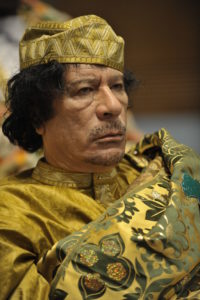
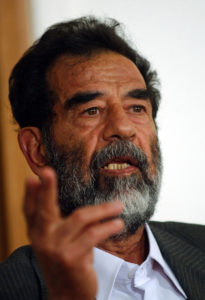
Both of those men once ran countries. Now they’re deposed and dead. The common factor? America. Call it imperialism. Call it empire building. Call it promoting democracy or protecting freedom. Call it exacting justice on two terrible butchers. From one perspective or another, all of those are the truth. What matters to North Korea is that these men tangled with America, they didn’t have nuclear weapons, and now they’re dead.
As far as I know (and the bloody purges at the start of his reign probably attest to this), Kim Jong-un doesn’t want to die. If he has a nuclear deterrent, he might fancy himself safe from any American led attempts at regime change and/or ending his horrific prison camp system.
You don’t have to take just my word for it though. Here’s a professor suggesting the same thing. Or you could just listen to what North Korea itself said:
The Saddam Hussein regime in Iraq and the Gaddafi regime in Libya could not escape the fate of destruction after being deprived of their foundations for nuclear development and giving up nuclear programmes of their own accord
2. What?
2.1 What should I know about nuclear weapons to understand this crisis?
It can be helpful to understand a bit about how nuclear weapons work before reading about using them. Here’s a very quick and slightly simplified rundown.
Nuclear weapons liberate energy from the nuclei of atoms. These can’t just be any atoms. You need the right version of the right atom to get a nuclear reaction. The ones relevant here are deuterium and tritium (forms of hydrogen with additional neutrons), plutonium-239 (commonly called “weapon grade plutonium”) and uranium-235 (“highly enriched uranium”).
There are two types of atomic reactions used in nuclear bombs. In fission weapons, plutonium or uranium atoms are split apart by the energy of a free neutron. This releases more neutrons setting in motion an unstoppable chain reaction (until the energy of it blows the fuel apart). The reaction is started by creating a critical mass. Weapon grade plutonium and highly enriched uranium are inherently unstable; at any given moment, a small number of atoms of either will be breaking apart, releasing neutrons. Get a large amount of either in one place (or compress an existing sample with explosives) and you’ll have enough neutrons to start the reaction.
Fusion is the opposite. In fusion, you slam two atoms together so hard that they merge. In fusion weapons, the fuel is a mix of deuterium and tritium (or a molecule called lithium deuteride, that turns into deuterium and tritium when exposed to neutrons). When you push these together hard enough, you get helium, energy, and a very, very energetic neutron. This neutron can then start fission reactions. In many thermonuclear weapons the true destructive power comes after these neutrons hit a very large outer shell of uranium, which then fissions very violently.
Fusion weapons are often called hydrogen bombs, because isotopes of hydrogen are used in them, or thermonuclear weapons, because high temperatures (among other things) are used to initiate the process of fusion. Not all bombs that use fusion are as destructive as “true” thermonuclear weapons (i.e. the things experts normally mean when they say “thermonuclear weapons”). It is possible to put a bit of deuterium and tritium into an “ordinary” fission bomb in order to generate some extra neutrons from fusion and speed up the chain reaction. This allows for more of the fuel to be used before it scatters itself around the landscape and increases the yield of the bomb.
Yields are commonly measured in kilotons (kt; equivalent to 1000 tons of TNT) or megatons (Mt; equivalent to 1,000,000 tons of TNT). A kiloton bomb is enough to do serious damage to a large city. A megaton bomb will utterly devastate it. Yields vary widely with design, but in general you’d expect a simple fission weapon to yield somewhere between 5 and 50 kilotons; a boosted weapon would normally yield between 25 and 150 kt; a fusion weapon can yield anywhere from 50 kilotons to 50 megatons. These ranges are just guidelines and have to do more with what is an efficient use of nuclear materials than anything else; you could make a one megaton boosted fission bomb (although that actually is the upper limit on what you can do without multi-stage fusion), but this would be very wasteful compared to creating a similarly destructive thermonuclear weapon.
Having a high yield in a small package is very important for miniaturization, the process of making a functioning atomic bomb small enough for delivery on a missile. When it comes to missiles, the smaller (and lighter) the warhead, the better. A lighter warhead allows a missile to travel further, a key requirement for countries like North Korea or America, with very distant adversaries.
If you’d like to read more about how nuclear weapons work, see my posts on the science underlying nuclear weapons and on nuclear weapon design.
2.2 What do we even know?
This is a really good question. Before I start on speculation or analysis, it’s important to talk about what we know for sure and what we can only speculate on.
Here are the facts:
- North Korea possesses a nuclear weapons program.
- North Korea has engaged in six known underground tests of their nuclear weapons.
- There could be additional failed tests that we don't know about.
- The latest test was on September 3, 2017 and caused a quake with a magnitude between 5.7 and 6.4 on the Richter scale.
- There doesn't exist an exact way to transform this into a yield – all estimates of the bombs power are estimates.
- These estimates range from 50kt to 250kt for the latest test[^1].
- North Korea successfully tested a missile in July with a range of 10,000 km (6,210 miles). This range is enough to reach the continental US and classify the missile as an Intercontinental Ballistic Missile (ICBM). In addition, a missile tested in 2016 had a range of 12,000km (7,450 miles).
- The United States has successfully shot down mock intermediate and medium range ballistic missile (IRBM/MRBM) in tests of its Terminal High Altitude Area Defense (THAAD) anti-missile system and mock ICBMs with its Ground-Based Midcourse Defense (GBM) anti-missile system.
Here are the serious unknowns:
- North Korea claims to have created a fusion weapon, but there exist other (less dangerous) technologies that could have been used in their last detonation. The precise type of their latest weapon hasn't been independently verified.
- North Korea claims that their nuclear weapons (including this latest one) are small enough to be mounted on their missiles (i.e. successfully miniaturized). Leaked intelligence suggests some of their earlier bombs are, but it's unclear if that applies to this latest one as well.
- North Korea claims to have a heat shield that will allow an ICBM to survive returning from space. This hasn't been independently verified.
- It is unknown if US ground missile defense systems could successfully intercept an ICBM aimed at the continental United States or IRBM/MRBM aimed at US possessions or allies closer to North Korea (e.g. Hawaii, Guam, Japan, South Korea).
2.3 What are your best guesses for what we don't know?
Oh my. Please remember that these are guesses.
2.3.1 Is this weapon fusion or boosted fission?
We won’t know for sure if the weapon the North Koreans detonated was “merely” a boosted fission bomb or a multistage fusion bomb until isotope analysis is completed (and even then, the results could be inconclusive or unreleased). I’m unwilling to hazard a guess here because I can make a plausible case either way. On one hand, boosted fission seems likely because it’s much easier than staged thermonuclear weapons. On the other, the North Koreans previously claimed to have detonated a thermonuclear bomb that clearly fizzled (if it indeed had a fusion stage). It doesn’t seem impossible that this failed test gave them the information necessary to make a successful multi-stage thermonuclear weapon.
I previously mentioned that testing would be necessary before any country could hope to reliably deploy multi-stage thermonuclear weapons. This is because there are a lot of unknowns in these weapons and it is hard to get them right. It’s much less surprising to see a country get their staged thermonuclear bomb right on the second try than it would be had they done it on their first.
There’s one final possibility, although it seems less likely. North Korea could have resurrected the old Sloika (layer-cake) nuclear weapon design. This is technically a thermonuclear weapon, but it requires a disproportionally (compared to its power) large mass of high explosives to work and lacks many of the desirable properties of the more conventional (staged) Teller-Ulam design (like the ability to chain as many additional stages as you’d like). The Sloika is currently regarded as a dead end in weapon development, but if the North wanted an impressive explosion to scare off the Americans and didn’t have any intent to ever put it on a rocket, it might be a good choice for them.
For what it’s worth, the United States army has chosen to treat the bomb as a thermonuclear weapon.
2.3.2 Is it miniaturized?
I don’t know. I want to believe that they haven’t successfully miniaturized this device (and that Kim Jong-un is posing with a fake in this picture). The first successful detonation of a multi-stage thermonuclear weapon required an 82-ton facility (Soviets mocked it as a “thermonuclear installation”). I find it hard to believe that in less than a year, North Korea could go from miniaturizing fission weapons to miniaturizing thermonuclear weapons, but it is possible that they have.
The recently released picture of Kim Jong-un with a “nuclear weapon” is certainly supposed to evoke a miniaturized multi-stage weapon. The distinct double humped shape (compare it to the single sphere of last year’s “disco ball of death”) suggests that there are two separate stages.
But this is a propaganda shot. Literally anything could be inside the enclosure in the pictures North Korea released (I actually think fissile material is the least likely thing to be in there, just based on how close Jong-un is to the thing; which isn’t to say that it couldn’t be identical in appearance to their actual weapons). It could be a true representation of their latest nuclear weapon designs, or it could be filled with lead. No one but Jong-un and his propagandists and senior subordinates know for sure.
Last year, North Korea claimed that a 10kt detonation was the successful test of a thermonuclear weapon capable of destroying the entire United States. We can’t trust official pronouncements about their nuclear weapons program. We can only trust the scarce scraps of hard evidence they leave.
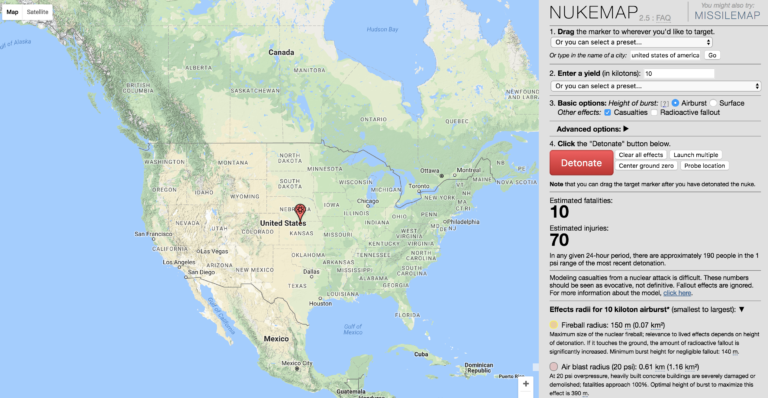
So, in this case, I think we’re going to have to wait for more US intelligence leaks before we know either way.
2.3.3 Does the heat shield work?
It might depend on the payload. Doctor John Schilling, writing for 38 North (a North Korea focused blog run by Johns Hopkins) believes that the heat shield failed for one of the two ICBM tests this summer. He thinks that North Korea has a successfully tested a heat shield that will work with very light payloads, but has been unsuccessful building one suitable for heavier payloads (such a heatshield would need to be rather light itself).
Depending on the mass of the miniaturized North Korean bombs, they might have a heatshield suitable for striking targets on America’s east coast, or they might not be able to reach even there. It does seem likely that they can reach Hawaii or Alaska with their current proven heat shield design.
North Korea has every incentive to play down the mass of their weapons and play up the strength of their heat shield, which is what makes determining the likelihood they can successfully strike America so challenging.
2.3.4 Can THAAD and GCM defend America (and its allies)?
THAAD and GCM have both succeeded in their last few tests, but it’s unclear how closely these tests mimic reality. Unfortunately, success is relatively new for the GCM system. Previously it’s failed about as often as it has succeeded. Real missiles will probably be even harder to successfully target than the dummies it’s been tested on.
THAAD has been fairly reliable, at least in its last few tests. But it is currently only deployed to protect a few US bases in Korea. Seoul is not within its range and even if it was, THAAD wouldn’t be able to protect the South Korean capital (and its millions of inhabitants) from the conventional artillery aimed at it by North Korea. There are also THAAD launchers in Guam, Hawaii, and Alaska, giving those territories some modicum of protection.
I honestly don’t know what probability to assign to these systems making a successful interception of a North Korean missile. I think the THAAD is more likely to succeed than the GCM, but I have no hard numbers to put on either.
3. How?
North Korea’s nuclear program has existed for more than three decades. But for many people, the latest tests are the first time they’ve really sat up and taken notice. To a certain extent, this makes sense. Before Kim Jong-un took over from his father, there had only been two nuclear tests and both of them were of fairly small bombs (the first was under 2kt, the second under 5kt).
If this is the first you’re seriously hearing about the crisis, it can help to get some of the historical context.
3.1 How expensive has the program been?
That’s a hard question to answer. The total cost direct cost is possibly between $1.1 billion and $3.2 billion, but it’s really hard to put hard numbers on anything that goes on in North Korea.
In addition to whatever North Kore has actually paid for its program, there’s the indirect costs. The program has led to international sanctions, the latest round of which will cost North Korea something like a billion dollars in exports. That doesn’t necessarily mean that their economy will shrink by a billion dollars though. The economic capacity that was consumed by the exports will still exist, but it will have to be used less efficiently (and may suffer from shortages of raw materials purchased with those exports). It will become harder for North Korea to acquire anything that it itself cannot produce and it will become less able to import food in the event of a famine or poor harvest. Those are both costly.
There’s also the opportunity cost. North Korea is incredibly impoverished, such that $1-3 billion dollars represents 3.5% to 10.5% of its entire yearly economic output. Had this been invested in a more economically useful fashion (e.g. in manufacturing or mining) North Korea would probably have a higher GDP. The opportunity cost of using this money in such a wasteful way cannot help but compound – that is to say the gap between what is and what could have been will only grow larger.
Here, I think a qualitative answer is best. The nuclear program has been incredibly expensive, but also – given that it is an excellent shield against regime change – worth it, at least from the perspective of Kim John-un.
3.2 Okay, but it's cheap compared to the $61.3 billion the US spent on nuclear weapons in 2011. How can they get so much with so little?
Really, the correct comparison is the Manhattan Project. It cost about $2 billion in the 1940s (about $20 billion today), still ten times more than the North Korean nuclear program.
I can think of two reasons for the discrepancy. First, the Manhattan Project created nuclear weapons from scratch. When the Manhattan Project started, nuclear weapons really were just a theoretical pipe dream. By demonstrating that nuclear weapons were possible, the Manhattan Program removed the theoretical question entirely.
But the Manhattan Project helped in ways beyond just demonstrating the technology was possible. Many other nuclear programs got help directly or indirectly from Manhattan Project scientists. Even the Soviet Union relied on the Manhattan Project to jump start their own nuclear weapons program (via the spy Klaus Fuchs, among others).
Of the nuclear powers, only America and India completed their nuclear programs without outside assistance, spies in other nuclear programs, or researcher exchanges. South Africa received assistance from Israel (and possibly France). Israel got assistance from France. France and the UK had scientists participate in the Manhattan Project. China got assistance from the USSR. The USSR conducted the aforementioned spying on the Manhattan Project. Pakistan received assistance from China (and possibly the United States) and in turn provided assistance to North Korea.
When China refused to provide Pakistan with missile technology, North Korea and Pakistan agreed to a swap. North Korea provided Pakistan with missiles, and Pakistan helped North Korea set up its nascent nuclear program. This assistance was no doubt invaluable. It probably helped North Korea avoid costly mistakes and dead ends.
The other reason for the cheap price tag is domestic. In America, the government cannot force scientists or labourers to work on atomic weapons and must pay a wage commensurate with each employee’s skills. The American government cannot force someone who finds atomic weapons distasteful to work on them against their will. For example, Joseph Roblatt was able to leave the Manhattan Project, even in the middle of all the paranoia stirred up by World War II.
North Koreans have none of that luxury. They work for whatever pittance the government chooses to give them and are executed or sent to prison camps if they refuse. There is no room for conscientious objectors or for negotiating on salary. Put plainly, the North Korean nuclear program is much cheaper than other nuclear programs because it is underlain with slavery and coercion.
3.3 How did things get so bad?
To rip off one of my favourite authors, “slowly, then all at once”.
There was an agreement to denuclearize North Korea signed by Clinton and Kim Jong-Il in 1994, when the North first began to make progress on its nuclear program. This agreement would have provided the North with proliferation-resistant nuclear power plants and free oil as those new power plants were constructed, as well as eventual sanctions relief and normalization of relations with the United States and South Korea. In return for this, North Korea agreed to remain bound by the Non-Proliferation Treaty (NPT) and submit to monitoring of its nuclear sites.
But this wasn’t a fully binding treaty and congress never secured the funds (it was signed right before the first midterm election of Clinton’s presidency, where Republicans took back the house). Delays repeatedly occurred on the American side and I’m not sure that the North Koreans ever fully suspended their nuclear program. No normalization of relations occurred, no sanctions were lifted, and George W. Bush eventually cancelled the agreement. North Korea soon announced that they were again developing nuclear weapons.
By 2006, North Korea had successfully tested a nuclear weapon. Another test followed in 2009, after a brief intervening suspension of the nuclear program. Both of these weapons were weak and probably very simple.
The nuclear program rapidly accelerated after Kim Jong-Il’s death in 2011. I’m of two minds about this. I’ve seen people claim that Jong-un has poured resources into the program to help prop up his standing internally, which certainly seems in keeping with his self-preservation instinct. But I also wonder if this could just be the natural result of North Korean scientists becoming more experienced and proficient in nuclear weapons production.
Either way, there have been four nuclear tests since Jong-un took power, three of them since 2016. The rapidity of these recent tests, their pairing with tests of missiles, and Trump’s bellicose response have combined to make the stand-off feel much direr than it has been at any other point in my life.
3.4 How many nuclear weapons does North Korea have? How does this compare to the US?
North Korea’s nuclear warhead count is unclear, but estimates range from 12 to 60.
There’s a big difference between prepared warheads, unassembled potential warheads in storage, and fissile material that can be used in warheads. When people estimate the number of warheads, they’re normally estimating the fissile material that the North Koreans could possess, probably assuming it’s all eventually going to active warheads. This assumption could be wrong if something other than fissile material – maybe highly technical bomb components? – is actually the limiting factor in North Korean warhead production.
The US has 1,550 active warheads1. These are the warheads that could be quickly deployed. The rest of its stockpile is in various states of readiness. I think some of them could be used relatively quickly (i.e. in a day or two), while others could be used only after a significant amount of refurbishment or preparation.
If North Korea has many active warheads (e.g. 60), an American first strike becomes impractical. It would be very hard to guarantee that all of them were destroyed (thereby preventing retaliatory strikes against the US or US troops in South Korea). Inactive nuclear weapons would still present a threat in the aftermath of a successful first strike, but it’s a threat that can be mitigated by sufficient damage to the chain of command or the logistic structure of the North Korean army.
Likewise, raw fissile material can be mostly neutralized as a threat by eliminating the state infrastructure necessary to turn it into finished warheads (it could still be used to create dirty bombs, but these are far less of a threat than nuclear warheads). It takes labour and speciality components to turn enriched fissile material into a reliable and functional weapon, prerequisites that are difficult to fulfill if the state that normally supplies them has collapsed.
I should also mention that very few (if any) of North Korea’s active warheads will be similar to the most recent test detonation. Many of their weapons will be relatively weak pure fission devices (similar in strength to their previous nuclear tests). Now that they have a warhead capable of ~150kt yields, they’ll certainly try and ramp up production of it (assuming that it’s at all practically useful and doesn’t weigh several tonnes), but that will take time.
Some experts seem to think that North Korea has much more access to enriched uranium than plutonium. This will further slow down their ability to build new weapons in the ~150kt range, at least if they want those weapons to be miniaturized2.
3.5 How bad would it be if North Korea used nuclear weapons?
Bad.
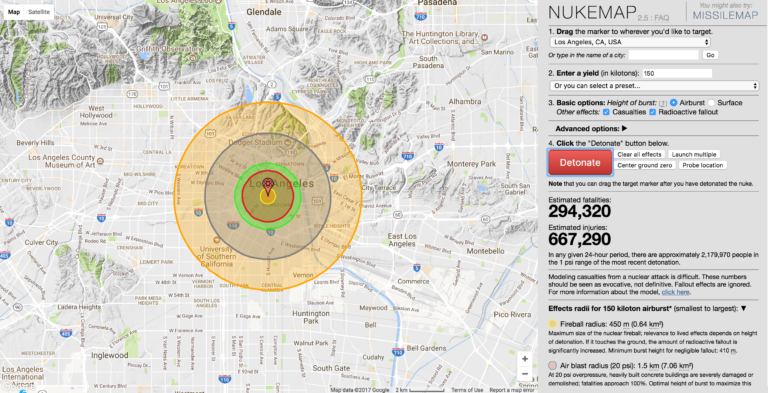

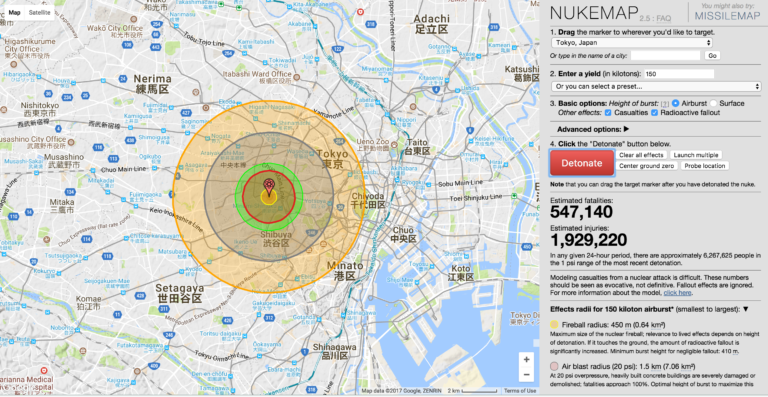
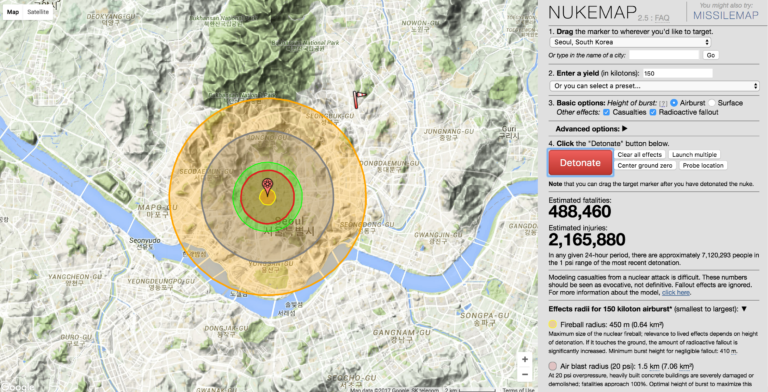
The latest North Korean weapon would (if it actually had a yield of 150kt and these casualty estimates are accurate) kill almost 300,000 people in LA, 270,000 people in SF, about 550,000 people in Tokyo, or 490,000 people in Seoul. If you want to get a sense of the destruction, you can play around with it on NukeMap. For cities on the US West Coast or in Asia and Europe, use a ~150kt bomb. For the East Coast, a 5-20kt bomb is probably more realistic (if one can be delivered at all)3.
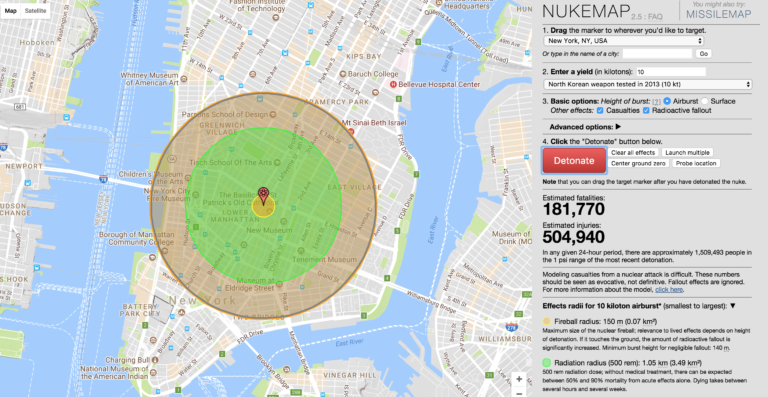
The danger is greatest for South Korea and Japan. Their cities are much denser (so nuclear weapons are more devastating) and much closer to North Korea (making it easy for the North Koreans to deliver larger warheads on missiles). There is also less in the way of missile defenses protecting major Asian cities, making bombs aimed at them much more likely to succeed.
That said, if North Korea ever used nuclear weapons, the greatest loss of life would be inside North Korea.
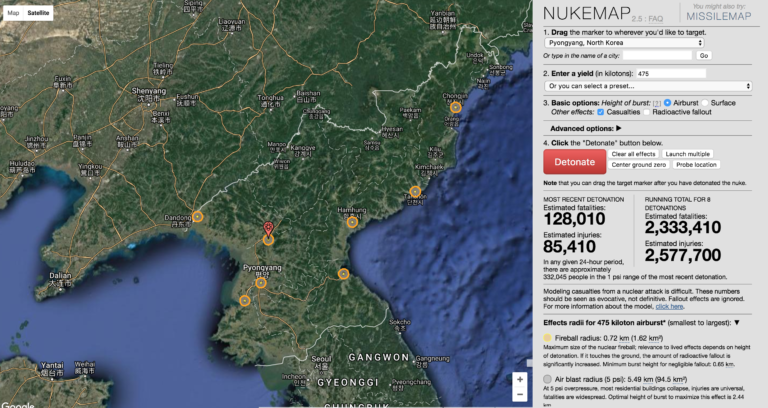
Right now, there should be at least one Ohio class submarine in an undisclosed location off of the Korean peninsula4. Each Ohio class submarine is armed with 24 Trident II missiles, which are tipped with up to 8 W76 or W88 nuclear warheads (the yield of a W76 is 300kt, the yield of a W88 is 475kt)5. These missiles have a range of 11,300 km. An Ohio class submarine can strike North Korea most quickly from the Sea of Japan or the East China Sea. But in a pinch anywhere in the Northern Pacific Ocean will do.
Each Ohio class submarine can carry several times as many warheads as North Korea possesses. One Ohio-class submarine with a full complement of warheads has almost the same nuclear arsenal as France.
If an Ohio class submarine were to unleash its payload on North Korea, the country would cease to exist in any meaningful way. Every single major popular centre would be irrevocably devastated. It would be destruction unlike the world has ever seen. It would make Hiroshima and Nagasaki look like child’s play. It would be the scourging of an entire country with nuclear hellfire.
Trump’s speech, where he promised “fire and fury unlike the world has ever seen” wasn’t hyperbole. It was a statement of fact. A single US nuclear ballistic missile submarine could easily make good on his threats. A single US nuclear tipped missile could make good on his threats.
(There are 14 Ohio class submarines, by the way.)
3.5.1 I've heard that nuclear weapons cause an electromagnetic pulse (EMP). How much damage could North Korea do with this?
Like most questions about nuclear weapon damage, this depends on several factors.
First, there’s a common misconception that a normal anti-material nuclear detonation (e.g. one within a few kilometers of the ground) creates an EMP effect that can do widespread damage. This is technically true – there is a large EMP effect – but practically irrelevant because the electromagnetic pulse will only really affect areas already ravaged by the bomb. Absent the other effects, it certainly would do significant damage, but it’s hard to think of a case where the most damage to a city attacked by a nuclear weapon will come from the EMP.
For the electromagnetic pulse to be the primary effect of a nuclear weapon, you must detonate a bomb outside the atmosphere. At this altitude, there will be no direct damage to the target, but some electronics will suffer.
The strength of this electromagnetic pulse depends on the type of bomb, its altitude, and the local strength of the magnetic field (the stronger the field, the stronger the EMP). The ideal nuclear weapon for producing EMP effects is a single stage weapon that produces a greater-than-average portion of its energy output in the form of gamma radiation and does this as quickly as possible6.
I don’t think North Korea has resources to invest in optimising for EMP effects. Development would probably require tests, which themselves require an expenditure of the government’s limited stockpile of fissile material. Since cost-effective and material-effective EMP weapons are normally single stage, North Korea would risk weakening their deterrent posture if they conducted these tests (to the US listening in with seismographs, it would look like they had regressed in their program and were failing to achieve fusion).
It also appears that most electronics, especially unplugged electronics would survive an EMP almost entirely unscathed. Computers, phones, and cars would largely be undamaged, but power lines would be heavily affected. This would be bad, but also probably not irrecoverable. A bunch of things would have to go horribly wrong for an EMP attack on America to cause more casualties than a thermonuclear attack on a large city. For this reason, I suspect North Korea’s would favour attacking population centres in any retaliatory second strike over high altitude EMP-producing bursts.
3.6 How do we get North Korea to give up its nuclear weapons program?
That is the most important question. President Trump likes to assert that China could get North Korea to stop. I once thought this was true, but I’ve abandoned that position as I’ve become better informed on the topic. If we give up on the idea that China can magically get North Korea to stop, it’s difficult to conceptualize North Korea giving up its weapons program. We don’t have a lot of examples of this occurring; the only singular history has to give us come from South Africa, which was briefly a nuclear power but later gave up its weapons. The parallels – both were international pariahs who felt weapons were necessary against an encroaching threat – offer perhaps the only blueprint for the denuclearization of the Korean peninsula.
3.6.1 How come China can't make North Korea stop?
China once saw North Korea as a buffer against American influence or aggression. North Korea was the fifth Chinese buffer zone7 – one of the client kingdoms that surround the Han heartlands of the state. To some extent, that’s still true. North Korea does provide a buffer between American allied South Korea and China. But at this point, North Korea is also a significant threat to China’s security.
The relationship between China and North Korea has significantly deteriorated since Kim Jong-un became leader. Jang Song Thaek – the uncle that Jong-un had executed – was one of the primary conduits for diplomacy between Pyongyang and Beijing. With his death, bilateral relations are largely stalled. Apparently, China hasn’t even been able to send an envoy to North Korea in more than a year.
Even before that though, mistrust characterized the relationship between Beijing and Pyongyang (on both sides). Kim Il-sung was almost executed by the Chinese communist party early in his life. Additionall disputes arose between the two countries during the Korean war and many of them haven’t been resolved since. There were even border skirmishes between the two nations in the late 1960s (I fact I didn’t know until I began researching for this section).
I don’t know why I didn’t realize this until I had it pointed out to me by 38north.org, but throughout history, client kingdom relationships have rarely been characterized by meek submission on the part of the client8. If you want an example of a heavily dependent ally that America cannot effectively control, look no further than Benjamin Netanyahu of Israel. In addition to ignoring American requests to stop settlements, he resolutely opposed Obama, even crossing the normal red line of meddling in American domestic politics. Why should we expect China’s client states to behave any differently than America’s?
At this point, China seems to believe they’ve lost any ability to control North Korea. They responded to the latest North Korean missile test with the test of an anti-ballistic missile system of their own. The location of this system? Between North Korea and Beijing. This is not something allies do. This isn’t even something that disinterested parties do. Pakistan and the UK both have nuclear weapons, but the US has put no effort into building missile defenses against either of them. China fears and mistrusts North Korea more than the United States fears and mistrusts Pakistan (which incidentally is also another excellent example of a rocky relationship between client and suzerain).
All of this means that a solution for the present crisis will not come only from Beijing. The engagement of Beijing is key to bringing North Korea to the table – we can’t accomplish anything without them – but we can no longer foist responsibility for North Korea onto China.
<h3 id=3.6.2”>3.6.2 Why did South Africa end its nuclear weapons program?</h3> In the 1970s South Africa was internationally isolated. It was banned from major sporting events and faced coordinated economic and military sanctions. It was fighting two separate guerilla wars and one conventional war. Thanks to intervention by Cuba and the USSR, (white) South Africans legitimately felt like they might soon be overrun by communists.
In this climate, they saw nuclear weapons as a salvation and a guarantee of independence. They could not use nuclear weapons to pacify their own people, but they thought that nuclear weapons might buy them breathing room and permanent protection from communism. For this, a token nuclear deterrent was enough – it’s unclear if their weapons were even usable, or if they intended to use the threat of them to prompt international aid if their borders were ever threatened9.
There was good reason for the world to sanction South Africa. Its apartheid system was despicable. It conducted one of the largest forced removals of people in history. It had a government without any principled claim to legitimacy. It was at war with its neighbours and had banned all dissent from its black citizens.
Many in South Africa wanted to prop up the system indefinitely. Many knew they were complicit in a great evil, but they feared death if apartheid were ever to unravel.
Does any of this sound familiar? South Africa had the same foundational paranoia that North Korea’s Kim dynasty currently possesses.
Here’s what happened. The sanctions – especially the sports bans – took their toll, demoralizing white South Africans. The Soviet Union fell, ending communism as an existential threat. Demographics forced the government to realized that they could only fight the tide of history for so long. F.W. de Klerk negotiated peace with the Angolans, the Namibians, the Cubans, and the ANC. He secured immunity for the state actors that had propped up apartheid. Then he dismantled his country’s nuclear weapons, followed shortly by his government.
This, I think, is the blueprint we must follow for North Korea. We should follow it not because it’s particularly attractive, but because it is the only blueprint we have.
3.6.3 How could we convince North Korea to give up its nuclear weapons?
First, the Americans and North Koreans would have to accept the current Chinese proposal, which would see North Korea pause its nuclear program and the US cancel joint military exercises with South Korea. This is actually similar in principle to the trilateral treaty that ended the conflict in Namibia and Angola. As a result of that treaty South Africa withdrew its forces, Cuba did the same, and Namibia ran democratic elections.
If there’s any backsliding or reluctance at all on the part of North Korea, then we can use some of the sticks that were particularly effective against South Africa, especially the sports ban (which seriously demoralized white South Africans). North Korea is currently allowed to compete in both the Olympics and FIFA. That should change. For as long as nuclear tests continue, all North Korean athletes should be banned from international competition. The North Korean government cares a lot about its successes in athletics (seeing them as proof of the power of juche), so taking that away from them would be a potent psychological blow.
If an American suspension of military drills fails to bring North Korea to the table, America will have strengthened its position with China at the same time as North Korea presents yet another embarrassment to Beijing. This will make it easier to coordinate even more damaging sanctions on Pyongyang. If Jong-un continues on this path, he risks well and truly alienating China, which would deeply cripple North Korea’s economy. I think at some point (e.g. if China gets pissed off enough that it threatens to stop guaranteeing North Korea against an attack), Kim Jong-un would have to blink and start bargaining with the powers arrayed against him
There are two paths that can be followed once the North freezes its nuclear program and America abandons its military drills. In the first, we can go back to where we were in the 1990s, but this time do it right. I’m personally pessimistic that this can lead to long term security, because totalitarian regimes and democracies can almost never co-exist, especially side by side. If North Korea remains under juche, some conflict with America will eventually escalate, ruin any existing deal, and lead to renewal of weapon’s research. I’m not opposed to buying time (every day where North Korea and America aren’t on a hair trigger is a day where far fewer people are at risk of dying!), but I’d also like to see this conflict settled for good.
Hence, the second path. It starts off like the first, with the world steadily upping the pressure on Kim Jong-un. But here, instead of just making this about nuclear weapons, we make it personal and we offer him a personal escape from his current situation10. A guaranteed life of ease may not be owning a country, but it competes favourably with being dead. The goal here would be to remove Jong-un and replace him with someone able to undertake the Korean equivalent of the Khrushchev Thaw or Deng Xiaoping’s reforms.
This would go hand in hand with the negotiations following the suspension of military drills and might involve the following:
- America removes all of its troops from South Korea
- Kim steps down as Supreme Leader. He and all of his cronies are guaranteed a state pension for as long as they live.
- North Korea agrees to abandon its nuclear program and accedes to the NPT and (after verification of the programs dismantling) the NSG.
- A transitional government is put in place in North Korea. Realistically, this government will have to be heavily influenced by Beijing, but that shouldn't rule out eventual re-unification.
I hate this plan. The only end that feels fitting for Kim Jong-un involves a firing squad.
But.
A nuclear war between North Korea and America will (at a minimum) kill millions. Every day that tensions remain this high on the peninsula risks that eventuality. The current state of uneasy paranoia is unacceptably dangerous11. Even a more stable stand-off, punctuated by brief periods of tensions this bad is too much of a risk.
North Koreans are not served by Kim Jong-un walking free and never facing justice. But they’re served even less by dying in a country turned into a conflagration.
I don’t know if this plan could work. I don’t know if there’s the political will. I don’t know if Trump or Jong-un can thread the needle, or walk the knife’s edge, or whatever metaphor you want to use for what would be an intensely difficult process. But I’m convinced that this plan, or something similar is the only way we can permanently de-escalate tensions on the Korean peninsula and remove North Korean weapons of mass destruction.
That’s the other reason I wrote this FAQ. Because I want people to have all of the context for this crisis. I want you to understand the true scope of devastation that any military response to North Korea would entail. I want you to understand that China cannot control North Korea. I want you to understand that missile defense is cold comfort. I want you to understand that we have done this before and we can do it again but that it will be hard and unsatisfying.
If you’ve made it this far, I have a favour to ask of you. Check my work. Make sure what I’ve written is correct. If I’m wrong, help me to understand this crisis even better. And if it checks out, tell other people what we know. Spread it as far as you can. Tell your friends, your coworkers. Tell your parents, your children. Help people understand what we have to do.
-
If it is following the limits outlined in the New START treaty with Russia. ↩
-
It requires much more in the way of conventional explosives to compress a uranium primary than a plutonium primary. Uranium has a higher critical mass than plutonium, which has the consequence of requiring a greater initial mass or greater compression before fission can be obtained. Either way, this requires more explosives to start the thing. My understanding is that multi-stage fusion bombs are never started with gun-type primaries, making implosion a necessity and eliminating one option for making uranium weapons more explosive-efficient. If you want to efficiently miniaturize a bomb, you need to bring along as little conventional explosives as possible. It’s this need that has driven technologies like boosted fission. ↩
-
For maximum casualties, use an airburst. To see fallout, use a surface burst. Airbursts are favoured against soft targets, like cities, ports, and military bases. Ground bursts are used against hardened targets, like nuclear silos or government bunker complexes.
In large nuclear weapons (and 150kt is large by any reasonable standard), most of the fatalities come from the shockwave and thermal radiation (as opposed to the central fireball or prompt radiation exposure). When a bomb is detonated closer to the ground, there’s much less of a shockwave and fewer people are exposed to dangerous thermal radiation, but some of the soil becomes radioactive and is dispersed as dangerous fallout. ↩ -
I don’t know this for sure, because undisclosed. But I would bet several thousand dollars that one is there. ↩
-
Missiles with multiple warheads mount them on multiple independent re-entry vehicles, or MIRVs. I’ve seen this verbed, as in “those missiles were MIRVed with eight warheads each”. Each re-entry vehicle can pick an independent target (within some radius of the initial target) as it re-enters the atmosphere. Hence the name.
Technically, the Trident II missiles can carry 14 MIRVed warheads, but treaties limit them to 8. Both the US and Russia are allowed (by bilateral treaty) to have up to 288 nuclear tipped sub-launched ballistic missiles (SLBMs), with up to 1152 warheads carried on those missiles (this is in addition to the maximum number of warheads allowed per missile). ↩ -
Gamma rays cause electromagnetic pulses by ionizing electrons in the upper atmosphere. These electrons circle magnetic field lines, producing a large oscillating electric and magnetic field, as well as acting as a giant coordinated synchrotron array. The gamma rays emitted from these synchrotrons cause a second, longer lasting and less intense pulse that can nonetheless damage systems weakened by the first pulse.
Single stage weapons more efficiently produce EMPS (compared to multi-stage weapons) because the first stage of multi-stage weapons can pre-ionize the air before gamma rays from the second stage reach it. Once air is ionized, the EMP will likely induce an opposite direction current in it, which will cancel out some of the EMP effect.
When gamma rays are produced extremely quickly (here, “quickly” really means “with little gap between production of the first and production of the last”), there is little chance for this opposite current to reduce the strength of the pulse. ↩ -
The others are Xinjiang, Inner Mongolia, Manchuria, and Tibet. ↩
-
The reason for this is almost always domestic. While it might be better for a country as a whole to reap the benefits of a close relationship with their protector, this is often hard for the leader of a country to pull off without appearing to be a foreign puppet (which is the sort of thing that leads to losing elections or dying in a coup, depending on how political systems are set up to transfer power). Seen this way, Kim Jong-un’s domestic paranoia is one of the driving forces of his estrangement from Beijing. See also The Iron Law of Institutions. ↩
-
This isn’t without precedent. During the Yom Kippur war, Israel assembled several nuclear weapons in plain view of US intelligence gathering assets. This is thought to have contributed (although it is unclear how much) to the subsequent American decision to re-supply Israel, replenishing its material losses from the early stages of the war. ↩
-
Offering an attractive escape is key. Ratcheting up the pressure without one just makes nuclear war more likely. We’re competing here with “90% chance I get to keep running my country, 10% chance I die horribly”, or the like. If we can’t make an offer that can attractively compete with this, we should avoid squeezing Kim too tightly, just in case he reacts (apocalyptically) poorly. ↩
-
When tensions are this high, accidents can easily start nuclear wars. Accidents happen. Let’s say (and I do not particularly believe these numbers are correct, but they are illustrative) you expect one accident a year and 30% of accidents cause a nuclear war. After five years, there is an 83% chance that a nuclear war will have broken out. It’s this small but consistent chance for a horrendous death toll that I so desperately want us to avoid. ↩
